| کد مقاله | کد نشریه | سال انتشار | مقاله انگلیسی | نسخه تمام متن |
|---|---|---|---|---|
| 1965012 | 1538637 | 2016 | 5 صفحه PDF | دانلود رایگان |
• The prevalence of painful diabetic polyneuropathy (PDPN) was 7.6% in an Ethnic Chinese population with T2DM.
• The risk of PDPN increased in the diabetic patients with less physical activity.
• The risk of PDPN was increased in the diabetic subjects with albuminuria.
• There was a joint effect of macroalbuminuria and no physical activity habit on PDPN risk.
BackgroundDiabetic neuropathy is a common complication in patients with type 2 diabetes. However, the prevalence of painful diabetic polyneuropathy (PDPN) have been less studied. We examined the prevalence and risk factors of PDPN in outpatients with type 2 diabetes in an ethnic Chinese population.MethodsThis retrospective study enrolled 2358 outpatients with type 2 diabetes who had completed the Douleur Neuropathique en 4 Questions (DN4) questionnaire from January 2013 to October 2013. Patients with a total score ≥ 4 were defined as having PDPN.ResultsIn all, 179 patients were diagnosed as having PDPN with a score of 4.49 on the DN4 questionnaire, compared with 0.66 for patients without PDPN. After adjusting the possible confounding factors, the risk of painful neuropathy was increased in the group without physical activity (Odds ratio 3.38, 95% CI 1.54–9.79), and in the group with macroalbuminuria (Odds ratio 2.31, 95% CI 1.44–3.73). Besides, there was a joint effect of macroalbuminuria and no physical activity habit on PDPN risk.ConclusionsThe prevalence of PDPN was 7.6% among our outpatients with type 2 diabetes. Less physical activity and albuminuria, respectively, increased the risk of PDPN and had a joint effect.
Journal: Clinica Chimica Acta - Volume 462, 1 November 2016, Pages 55–59
